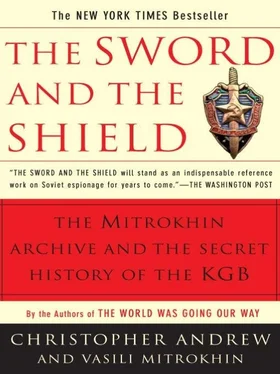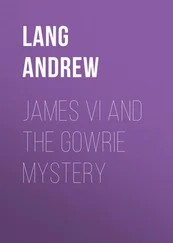The most effective damage limitation measure taken by the MGB after Bentley’s defection was to break off contact with most of the wartime American agents whose identities were known to her. As a result, Bentley’s many leads resulted in not a single prosecution. The FBI began its investigations too late to catch any of the spies named by Bentley in the act of passing on classified information, and it was unable to use evidence from wiretaps in court. The Centre, however, failed to grasp the extent of the legal obstacles which confronted the FBI and continued to fear for several years that it would succeed in mounting a major spy trial.
The Centre’s fears were strengthened by a major American codebreaking success, later codenamed VENONA. For its high-grade diplomatic and intelligence communications the Soviet Union had used since 1927 a virtually unbreakable cipher system known in the West as the “one-time pad.” 36During and immediately after the Second World War, however, some of the one-time pads were reissued, thus becoming vulnerable—though it took several years for American and British codebreakers to exploit the difficult opportunity offered to them by Soviet cryptographic carelessness. Late in 1946 Meredith Gardner, a brilliant cryptanalyst in the US Army Security [SIGINT] Agency, began decrypting some of the wartime messages exchanged between the Centre and its American residencies. By the summer of 1947 he had accumulated evidence from the decrypts of massive Soviet espionage in the wartime United States. In 1948 ASA called in the FBI. From October special agent Robert Lamphere began full-time work on VENONA, seeking to identify the agents (some still active) whose codenames appeared in the VENONA decrypts. 37Remarkably, however, the Central Intelligence Agency was not informed of VENONA until late in 1952. 38Even more remarkably, President Truman appears not to have been told of the decrypts, perhaps for fear that he might mention them to the Director of Central Intelligence, head of the CIA, at one of his weekly meetings with him. VENONA showed in graphic detail how OSS, the CIA’s wartime predecessor, had been heavily penetrated by Soviet agents. Both Hoover and the Chairman of the Joint Chiefs of Staff, General Omar N. Bradley, seem to have suspected—wrongly—that the same was true of the Agency. 39
The Centre learned the VENONA secret in 1947—five years earlier than the CIA—from an agent in ASA, William Weisband (codenamed ZHORA). 40The son of Russian immigrants to the United States, Weisband was employed as a Russian linguist and roamed around ASA on the pretext of looking for projects where his linguistic skills could be of assistance. Meredith Gardner recalls Weisband looking over his shoulder at a critical moment in the project late in 1946, just as he was producing one of the first important decrypts—an NKGB telegram of December 2, 1944 which revealed Soviet penetration of Los Alamos. 41
For the Centre, VENONA represented a series of unpredictable timebombs which threatened to explode over the next few years. It had no means of knowing precisely what NKGB telegrams would be decrypted in whole or part, or which Soviet agents would be compromised by them. Moscow’s anxieties were heightened by the public controversy which broke out in the United States in the summer of 1948 over Soviet espionage. In July 1948 Elizabeth Bentley gave evidence in public for the first time to the House Committee on Un-American Activities and achieved instant media celebrity as the “Red Spy Queen.” In evidence to the committee in early August, Whittaker Chambers identified Hiss, White and others as members of a secret pre-war Communist underground. The Centre wrongly feared that the committee hearings would be the prelude to a series of show trials which would expose its wartime espionage network.
DURING THE LATE 1940s Soviet foreign intelligence operations were further confused by a major reorganization in Moscow, prompted by the American National Security Act of July 1947 which established a Central Intelligence Agency “for the purpose of coordinating the intelligence activities of the several government departments and agencies in the interest of national security.” Though that coordination was never fully achieved, Molotov argued that the unified foreign intelligence apparatus envisaged by the National Security Act would give the United States a clear advantage over the fragmented Soviet system. The solution, he argued, was to combine the foreign intelligence directorates of both the MGB and the GRU under a single roof. Molotov’s proposal had the further advantage, from Stalin’s viewpoint, of weakening the power of Beria, whose protégé, Viktor Semyonovich Abakumov, headed the MGB. 42In October 1947 the foreign intelligence directorates of the MGB and GRU were combined to form a new unified foreign intelligence agency, the Committee of Information (Komitet Informatsii or KI). 43Under the new, highly centralized system, even the operational plans for arranging meetings with, and investigating the reliability of, important agents required the prior approval of the KI. 44
The appointment of Molotov as first chairman of the Committee of Information gave the Foreign Ministry greater influence on foreign intelligence operations than ever before. The first deputy chairman, responsible to Molotov for day-to-day operations, was the relatively pliant Pyotr Vasilyevich Fedotov, who had become the MGB foreign intelligence chief in the previous year. 45Like most of the Centre management, Fedotov had almost no experience of the West. Roland Abbiate, the former resident in New York and probably the senior intelligence officer best acquainted with the West, was sacked on the formation of the KI. His file records that he was given no explanation for his dismissal and that “it was a terrible blow for him.” Though the reason for the sacking is not recorded, it may well have been related to his foreign Jewish ancestry, which is duly noted in his file. Abbiate was briefly reinstated after Stalin’s death, then sacked again and later committed suicide. 46
Molotov sought to strengthen Foreign Ministry control of KI operations by appointing Soviet ambassadors in major capitals as “chief legal residents” with authority over both civilian (ex-MGB) and military (ex-GRU) residents. In the jaundiced view of the later KGB defector Ilya Dzhirkvelov:
This resulted in incredible confusion. The residents, the professional intelligence officers, resorted to incredible subterfuges to avoid informing their ambassadors about their work, since the diplomats had only amateurish knowledge of intelligence work and its methods… 47
Some diplomats, however, became directly involved in intelligence operations. After the troubles in the Washington residency which led to the recall of two successive residents in 1948-9, the Soviet ambassador, Aleksandr Semyonovich Panyushkin, took personal charge for a year. He acquired such a taste for intelligence that he later became head of the KGB First (foreign intelligence) Chief Directorate. 48
In 1949 Molotov, now out of favor with Stalin, was succeeded as both Foreign Minister and chairman of the KI by his former deputy, Andrei Vyshinsky, who had made his reputation as the brutal prosecutor in the prewar show trials. Vyshinsky retained a sycophantic devotion to Beria which showed itself even on the telephone. According to one of his successors, Andrei Gromyko, “As soon as he heard Beria’s voice Vyshinsky leapt respectfully out of his chair. The conversation itself also presented an unusual picture: Vyshinsky cringed like a servant before his master.” 49Unlike Molotov, Vyshinsky had little interest in KI affairs, handing over the chairmanship after a few months to Deputy Foreign Minister Valerian Zorin. Fedotov was succeeded as first deputy chairman in charge of day-to-day operations by the more brutal and decisive Sergei Romanovich Savchenko, like Vyshinsky a protégé of Beria. Savchenko seems to have answered to Beria rather than the Foreign Ministry. 50
Читать дальше











